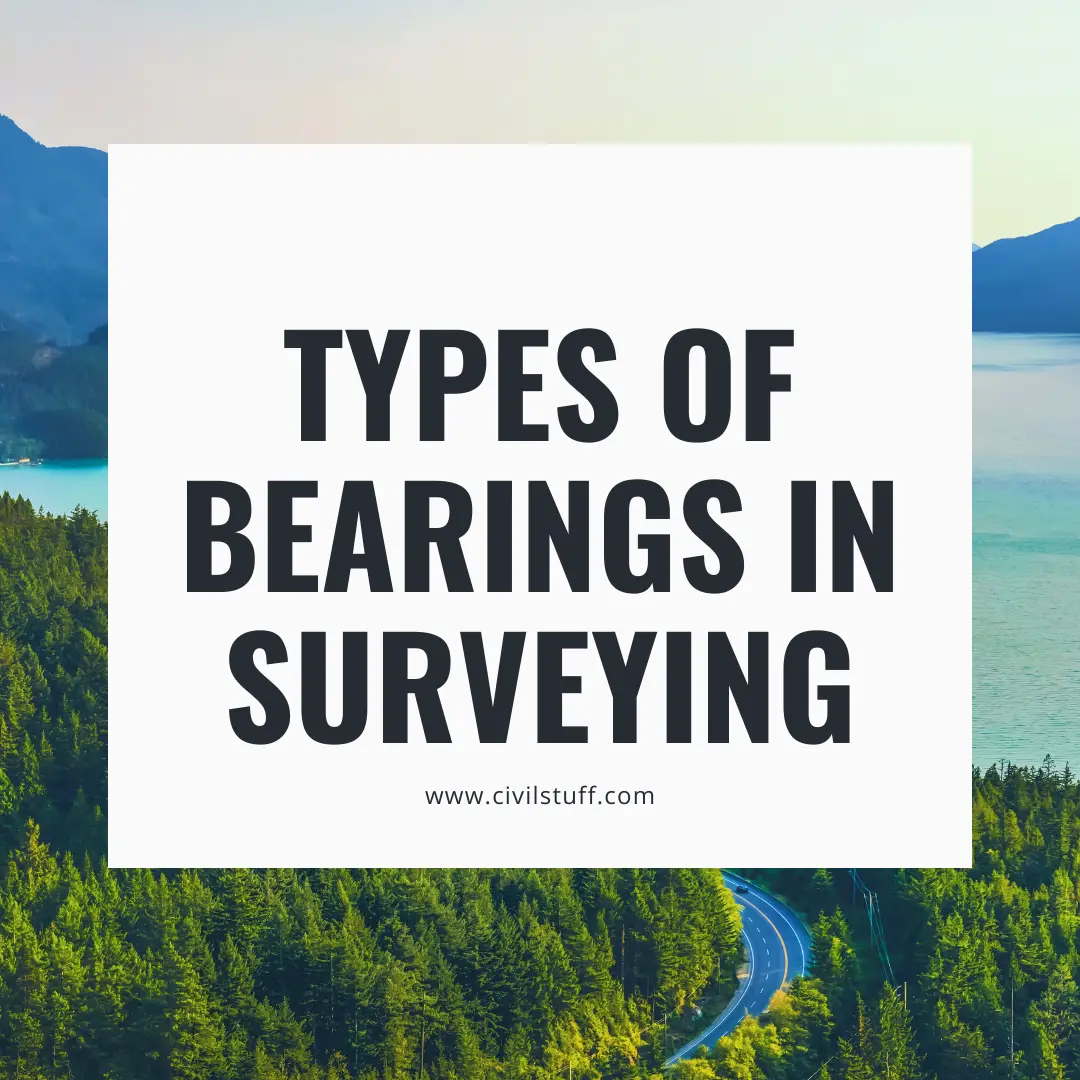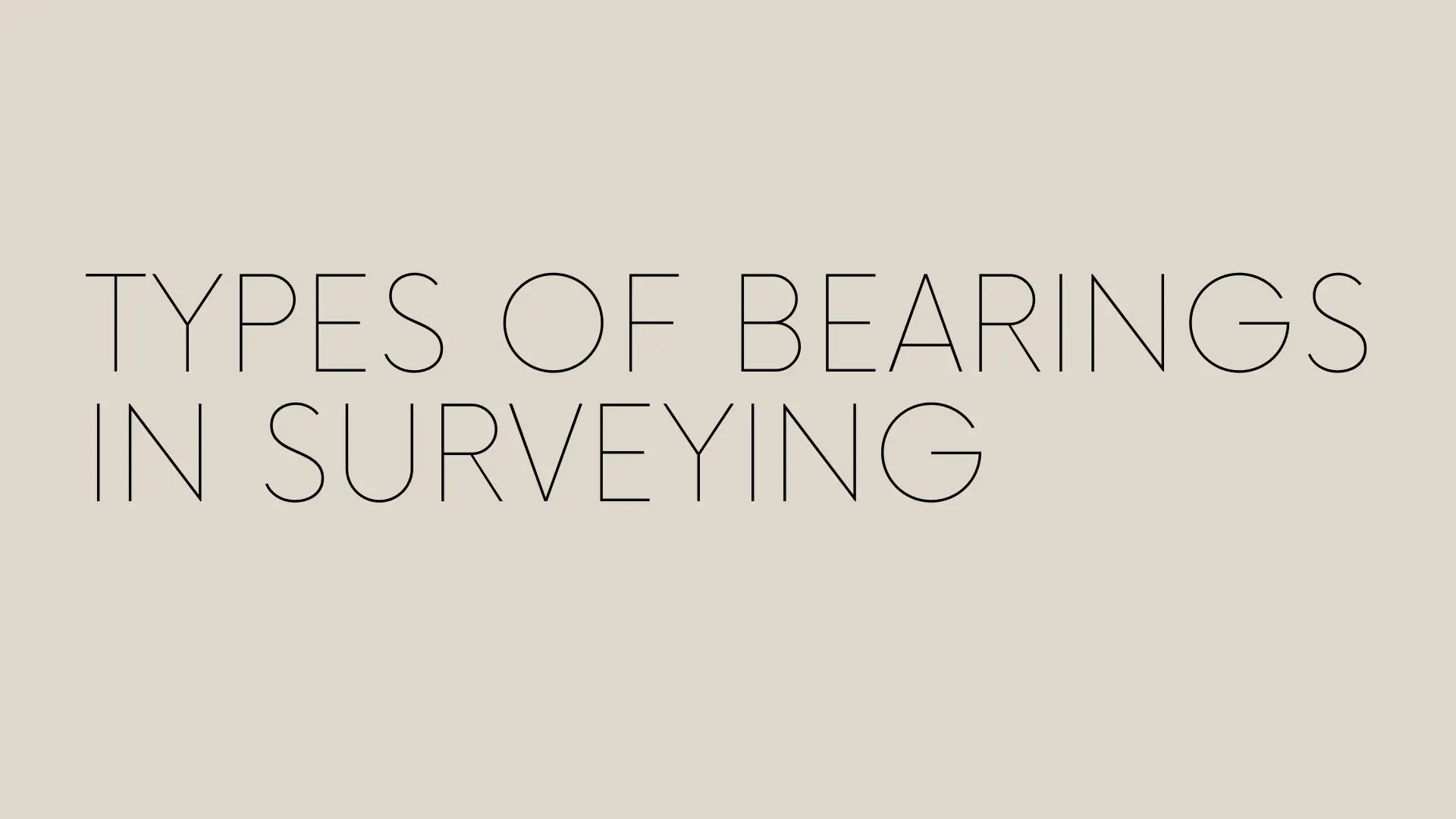Types of Bearings in Surveying

Types of Bearings in Surveying
Types of Bearings
To understand what bearings are, you need to first understand the other activities that take place during a survey.
During a survey, marks are set at known distances apart and angles to one another in order to accurately lay out the land.
A “bearing” is the angle between two of these marks. You can think of it as an imaginary line that connects two points on earth’s surface (either vertical or horizontal) from which we measure the angle away from true north (+N) or clockwise (-W).
Bearings are most commonly used when measuring slopes or drain lines.
💥🎁 Christmas & Year-End Deals On Amazon !
Don't miss out on the best discounts and top-rated products available right now!
🛒 Shop Now and Save Big Today!*As an Amazon Associate, I earn from qualifying purchases.
There are four types of bearings,
A line’s bearing is its orientation in relation to a certain meridian. A meridian is any direction, including True meridian, magnetic meridian, and arbitrary meridian.
-
The true meridian
True meridian through a point is the line formed by a plane passing through the true north and south poles and intersecting the earth’s surface. As a result, it travels through the true north and south. Astronomical observations can be used to determine the direction of the real meridian through a point.
True Bearing: The correct bearing of a line is the horizontal angle formed by it with the true meridian at one of its extremities. Because the real meridian through a point is constant, the true bearing of a line is a constant amount.
-
Magnetic Meridian
The magnetic bearing through a point is the direction represented by a freely floating and balanced magnetic needle free of any other attractive forces. A magnetic compass can be used to determine the direction of the magnetic meridian.
💥🎁 Christmas & Year-End Deals On Amazon !
Don't miss out on the best discounts and top-rated products available right now!
🛒 Shop Now and Save Big Today!*As an Amazon Associate, I earn from qualifying purchases.
Magnetic bearing: A line’s magnetic bearing is the horizontal angle formed by the magnetic meridian passing through one of the line’s extremities. It is measured with a magnetic compass.
-
Arbitrary meridian
An arbitrary meridian is any convenient direction towards a permanent and prominent mark or signals, such as a church spire or the top of a chimney. These meridians are used to identify the relative positions of lines in a small area.
Arbitrary bearing: A line’s arbitrary bearing is the horizontal angle formed by any arbitrary meridian passing through one of its extremes. It is measured with a theodolite or sextant.
-
Grid bearing
A grid bearing is measured using the direction northwards along the grid lines of the map projection as a reference point. The grid lines are chosen in such a way that they are parallel to the meridians and perpendicular to the parallels.
A line’s grid bearing is its horizontal angle with a grid line running through one of its extremities. The true bearing and magnetic bearing are determined from the grid bearing by subtracting or adding 35° respectively.
💥🎁 Christmas & Year-End Deals On Amazon !
Don't miss out on the best discounts and top-rated products available right now!
🛒 Shop Now and Save Big Today!*As an Amazon Associate, I earn from qualifying purchases.
Designation of Bearings
The common bearing designations used in surveying are:
- Whole circle bearing system
- Quadrantal bearing system
- Fore Bearing (FB) or forward bearing (FB)
- Back bearing or Backward bearing (BB)
- Calculated bearing
Whole circle bearing system
In this system, the bearing of a line is measured clockwise from magnetic north. As a result, the bearing’s value ranges from 0 to 360 degrees. In this method, the Prismatic Compass is graduated.
Example: If a line makes up part of the circumference of a circle, its bearing would be the angle it makes with that circle’s center.
This method is used to measure a line’s bearing relative to another fixed point or object.
Quadrantal bearing system or Reduced bearing.
💥🎁 Christmas & Year-End Deals On Amazon !
Don't miss out on the best discounts and top-rated products available right now!
🛒 Shop Now and Save Big Today!*As an Amazon Associate, I earn from qualifying purchases.
In this approach, a line’s bearing is measured eastward or westward from north or south, depending on which is closest.
Thus, both north and south are used as reference meridians, and the direction can be either clockwise or anticlockwise depending on where the line is located.
In a quadrantal bearing system, the quadrant in which lines are located must be specified. The surveyor’s compass is used to observe these bearings.
The quadrantal bearing system is used when a line’s bearing is measured to one of four points on the periphery of a circle.
Example: If a line makes up part of the circumference of a circle, its bearing would be the angle it makes with that circle’s center.
💥🎁 Christmas & Year-End Deals On Amazon !
Don't miss out on the best discounts and top-rated products available right now!
🛒 Shop Now and Save Big Today!*As an Amazon Associate, I earn from qualifying purchases.
For the quadrantal method, four arbitrary meridians are selected with equal distances between them. The true bearings of these meridians are noted on my chain or chain and log.
Fore Bearing (FB) or forward bearing (FB)
Forebearing or forward bearing refers to bearings measured while surveying, i.e., in the forward direction of survey lines.
Example: A surveyor places his stake some distance away from a line he is surveying. By sighting the stake against the Celestial body, he can calculate the angle between the two. By measuring that angle and calculating its bearing, he points his instrument in the correct direction of survey.
Forebearing or forward bearing refers to bearings measured while surveying, i.e., in the forward direction of survey lines.
Back Bearing (BB) or backward bearing (BB)
Backward Bearing refers to bearings measured in the opposite direction of surveying progress, i.e., in the backward direction of the survey line.
💥🎁 Christmas & Year-End Deals On Amazon !
Don't miss out on the best discounts and top-rated products available right now!
🛒 Shop Now and Save Big Today!*As an Amazon Associate, I earn from qualifying purchases.
A backward bearing is a line’s position relative to a point, a reference point, or an object. A line’s backward bearing is the angle formed by all three.
Example: If a line makes up part of the circumference of a circle, its bearing would be the angle it makes with that circle’s center.
Calculated Bearing
Calculated bearings are those line bearings that are not measured during surveying progress but are calculated based on other known bearings already taken and/or distances already measured.
Calculated bearings are used to find other bearings and distances such as true bearing, back bearing, etc. These are known as “intermediate” or “working” bearings and distances.
Example: This can be used in applying PLS rule 1.5, which states that any two-line segments in a plane have one and only one common perpendicular.
Summary
💥🎁 Christmas & Year-End Deals On Amazon !
Don't miss out on the best discounts and top-rated products available right now!
🛒 Shop Now and Save Big Today!*As an Amazon Associate, I earn from qualifying purchases.
In summary, the four systems of bearings are all of equal use in surveying. The difference between them is more a matter of the method used to determine the bearings than of their accuracy.
The simplified whole circle bearing system is generally easier to use and maintain than the quadrantal system and also less prone to errors.
The former is also suited to instruments with a short radius, e.g., the prismatic compass and the theodolite while the latter is adopted for those with longer radii, e.g. the plane table and Transit Instrument.
The choice of a method of determining line bearings depends mainly on surveyors’ preferences and also on the instruments used for their measurements.
FAQs
What is bearing and types of bearing in surveying?
Bearing is the simple direction traveled by an object.
💥🎁 Christmas & Year-End Deals On Amazon !
Don't miss out on the best discounts and top-rated products available right now!
🛒 Shop Now and Save Big Today!*As an Amazon Associate, I earn from qualifying purchases.
There are different types of bearing which are used in surveying such as True, Magnetic and arbitrary
- True bearing- The true bearing of a line is the angle measured clockwise from magnetic north.
True bearings are used to measure the bearing of a line relative to some fixed point or object.
- Magnetic bearing- The magnetic bearing of a line is the angle formed by that line and magnetic north.
Magnetic bearings are used to measure the surveyor’s compass direction only, not for map measurements.
- Arbitrary bearing- The arbitrary bearing is the horizontal angle formed by any arbitrary meridian passing through one of its extremes.
What is meridian and bearing?
The meridian is a large circle that travels across true north and true south. Bearing is the direction supplied by the acute angle formed by a line and a meridian.
What is true meridian in surveying?
The true meridian is defined as the plane that runs across the true north pole (geographical north pole) and the true south pole (geographical south pole) at the location of observation. National survey departments’ maps are based on the correct meridians.
What is the difference between meridian and longitude?
💥🎁 Christmas & Year-End Deals On Amazon !
Don't miss out on the best discounts and top-rated products available right now!
🛒 Shop Now and Save Big Today!*As an Amazon Associate, I earn from qualifying purchases.
Longitude is defined as the distance east or west of the prime meridian. Longitude is measured by imaginary lines that go vertically (up and down) around the Earth and meet at the North and South Poles.
These lines are referred to as meridians. Each meridian corresponds to one arc degree of longitude.
What is the difference between true meridian and arbitrary meridian?
Astronomical observation can be used to determine the real meridian as it travels through true north and south. True bearing is the horizontal angle formed by the true meridian and a line.
An arbitrary meridian is any convenient direction towards a well-defined permanent object.
Is meridian magnetic?
The meridian is not magnetic, but the direction measured along its path is called magnetic bearing. The true north pole and true south pole are located in the north and south magnetic poles.
💥🎁 Christmas & Year-End Deals On Amazon !
Don't miss out on the best discounts and top-rated products available right now!
🛒 Shop Now and Save Big Today!*As an Amazon Associate, I earn from qualifying purchases.
The compass needle points to the geographic poles, which are actually 90 degrees away from the geographic poles. Since compasses were built to point north-south, they always point toward the geographic pole instead of magnetic pole.
How are bearings taken?
Bearing can be determined with survey instruments or by using simple tools such as an optical device such as an astrolabe or theodolite. The method of determining the line’s bearing depends on the instrument used.
When taking bearings with instruments, the angle of sight or the pointing direction of a device should be held against the celestial body for observation to determine the true bearing of a line.
The instrument can be moved along a line and its angle adjusted until it is perpendicular to line and when sighted against celestial body, this mean that it is accurately positioned. This setting up procedure is referred to as setting up an instrument for surveying.
What is the shape of meridian?
As a result, the shape of the meridians is circular. Unlike range parallels, which can be circles, longitude meridians are semicircles that intersect at the poles. They form a circle if opposing meridians are taken together, yet they are willing to be closer as meridians separately.
What is azimuth in survey?
💥🎁 Christmas & Year-End Deals On Amazon !
Don't miss out on the best discounts and top-rated products available right now!
🛒 Shop Now and Save Big Today!*As an Amazon Associate, I earn from qualifying purchases.
Azimuths are horizontal angles measured in the clockwise direction from the reference meridian. Azimuths are sometimes referred to as a whole circle bearing system (W.C.B). Azimuths are commonly employed in compass surveying and plane surveying, where they are measured from the north.
Which is the best definition of the meridian?
Any imaginary semicircle on the earth’s surface extending from the north pole to the south pole. or alternatively: A representation of a meridian on a map or globe that is numbered according to degrees of longitude.
What is true bearing and magnetic bearing?
True bearing and magnetic bearing are terms used in geography to refer to true north and magnetic north, respectively. The direction pointing to the North Pole is known as true north. True north is depicted on a map by meridians or lines of longitude.
Magnetic north, on the other hand, is the direction that points to the magnetic pole.
What is the formula of true bearing?
True Bearing = (Magnetic Bearing + Declination) = (89°45 + 5°30) = 95°15
What is bearing angle?
💥🎁 Christmas & Year-End Deals On Amazon !
Don't miss out on the best discounts and top-rated products available right now!
🛒 Shop Now and Save Big Today!*As an Amazon Associate, I earn from qualifying purchases.
A bearing is the angle in degrees measured clockwise from north in mathematics. Bearings are often specified as a three-figure bearing. 30° clockwise from north, for example, is generally written as 030°.
What is FB and BB in surveying?
Bearings measured in the survey’s progress direction are known as fore bearings, whereas bearings measured in the opposite direction of the survey are known as back bearings.
What is forward bearing?
The bearing of the line in the forward direction of surveying is referred to as the fore bearing. The formula for calculating the progressive line’s fore bearing is F.B = B.B 180° + sign when B.B is less than 180° and − sign when B.B is greater than 180°.
What is relative bearing?
The angle between the forward direction of the ship and the location of another object is referred to as relative bearing. An object relative bearing of 0 degrees, for example, would be dead ahead; an object relative bearing of 180 degrees would be behind.
What exactly is whole circle bearing?
Whole circle bearing (WCB) is defined as the bearing of a line at any point measured with regard to the Meridian. The values for Whole Circle bearings range from 0° to 360°. In the Prismatic compass, the Whole circle bearing is commonly utilized.
What is grid bearing?
💥🎁 Christmas & Year-End Deals On Amazon !
Don't miss out on the best discounts and top-rated products available right now!
🛒 Shop Now and Save Big Today!*As an Amazon Associate, I earn from qualifying purchases.
A horizontal angle measured clockwise with reference to grid north that expresses the direction of an object from a point.
What is square bearing?
Square bore ball bearings are specialized products that have all of the properties of normal Single Row Ball Bearings except that the inner ring has a square interior built for a square shaft rather than a round shaft. These items are also commonly measured in inches rather than metric measurements.


